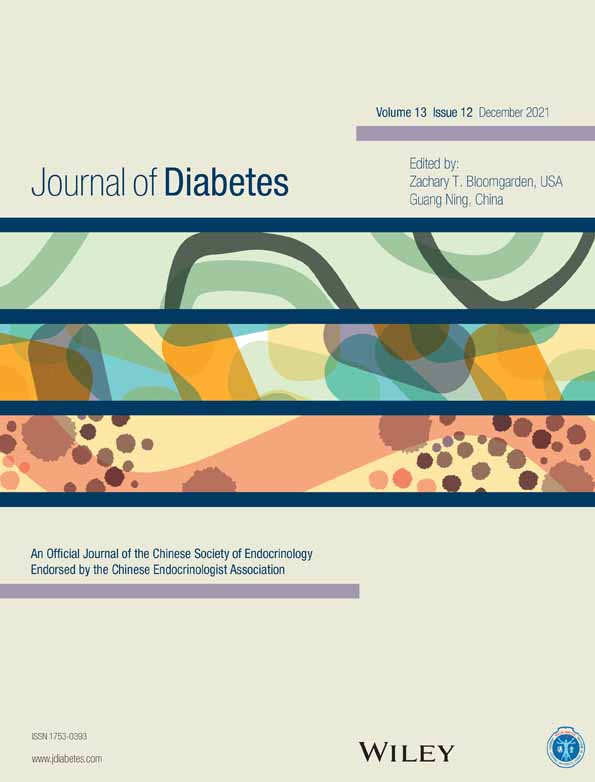Integrated analysis of probability of type 2 diabetes mellitus with polymorphisms and methylation of KCNQ1 gene: A nested case-control study
KCNQ1基因多态性和甲基化与2型糖尿病发病风险关系的巢氏病例对照研究
Funding information: Medical Research Foundation of Guangdong Province, Grant/Award Number: A2017181; National Natural Science Foundation of China, Grant/Award Numbers: 81373074, 81402752, 81673260; Natural Science Foundation of Guangdong Province, Grant/Award Number: 2017A030313452; the Science and Technology Development Foundation of Shenzhen, Grant/Award Numbers: JCYJ20140418091413562, JCYJ20160307155707264, JCYJ
Abstract
enBackground
To estimate the associations between single-nucleotide polymorphisms (SNPs) and methylation of KCNQ1 gene and type 2 diabetes mellitus (T2DM) risk and the interactions among SNPs, methylation, and environmental factors on T2DM risk.
Methods
We genotyped five SNPs and tested methylation at 39 CpG loci of KCNQ1 in 290 T2DM cases and 290 matched controls nested in the Rural Chinese Cohort Study. Conditional logistic regression model was used to estimate the associations between SNPs and KCNQ1 methylation and T2DM risk. Multifactor dimensionality reduction (MDR) analysis was used to estimate the effect of the interactions SNPs-SNPs, SNPs-methylation, methylation-methylation and SNPs, and methylation-environment on T2DM risk.
Results
Probability of T2DM was decreased with rs2283228 of KCNQ1 (CA vs AA, odds ratio [OR] = 0.65, 95% confidence interval [CI] 0.42-0.99). T2DM probability was significantly increased with rs2237895 combined with hypertriglyceridemia (OReg = 2.76, 95% CI 1.35-5.62), with hypertension (OReg = 2.23, 95% CI 1.25-3.98), and with body mass index (BMI; OReg = 1.93, 95% CI 1.12-3.34). T2DM probability was associated with methylation of CG11 and CG41 (OR = 1.89, 95% CI 1.23-2.89, P = .003). It was significantly associated with the interaction between BMI, hypertriglyceridemia, and CG5 methylation (P = .028 and .028), and the combined effects of CG11 with hypertriglyceridemia and hypertension. On MDR analysis, no significant interaction was observed.
Conclusion
T2DM probability was reduced 35% with rs2283228 polymorphism. It was associated with rs2237895 combined with hypertension, with BMI and with hypertriglyceridemia. The methylation at two CpG loci of KCNQ1 significantly increased T2DM risk by 89%.
摘要
zh目的
研究KCNQ1基因单核苷酸多态性(SNPs)和甲基化与2型糖尿病(T2DM)发病风险的关系, 以及SNPs、甲基化和环境因素的交互作用与T2DM发病风险的关系。
方法
采用巢氏病例对照研究, 对来自于中国农村队列研究的290例T2DM患者和290例匹配对照进行KCNQ1基因的5个SNP基因分型和39个CpG位点甲基化检测。采用条件Logistic回归模型分析评估KCNQ1基因SNP和甲基化与T2DM发病风险之间的关系。采用多因素降维(MDR)分析评估SNPs–SNPs、SNPs–甲基化、甲基化–甲基化以及SNPs–环境和甲基化–环境交互作用。
结果
KCNQ1基因rs2283228显著降低了T2DM的发病风险(CA v.s AA, 比值比[OR]=0.65, 95%置信区间 [CI] 0.42-0.99)。rs2237895基因型与高甘油三酯血症(OReg=2.76, 95%CI 1.35-5.62)、高血压(OReg=2.23, 95%CI 1.25-3.98)和体量指数(BMI)(OReg=1.93, 95%CI 1.12-3.34)对T2DM发病存在显著的协同作用。T2DM的发病风险与CG11和CG41甲基化呈正相关(OR=1.89, 95%CI: 1.23-2.89, P = .003)。CG5甲基化与超重和高甘油三酯血症对T2DM发病存在显著交互作用(P = .028和.028)。CG11甲基化与高甘油三酯血症和高血压对T2DM发病存在显著协同作用。在MDR分析中, 未观察到显著的交互作用。
结论
KCNQ1基因rs2283228可以降低35%的T2DM发病风险。rs2237895与高甘油三酯血症、高血压和超重对T2DM发病存在显著的协同作用。KCNQ1基因2个CpG位点甲基化显著增加了89%的T2DM发病风险。




